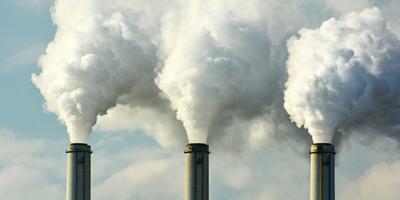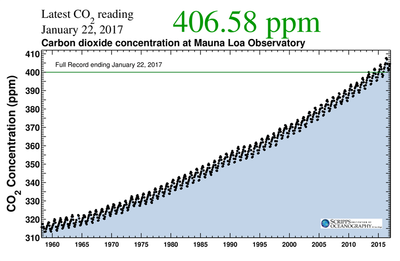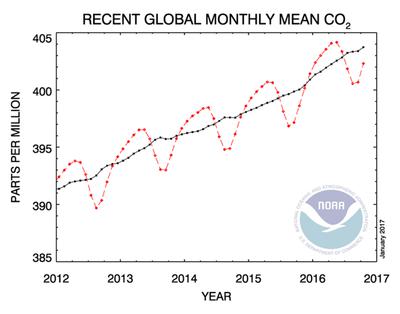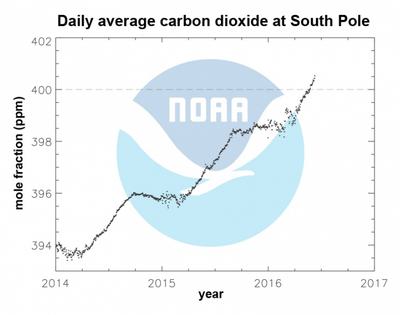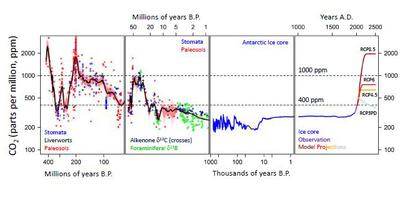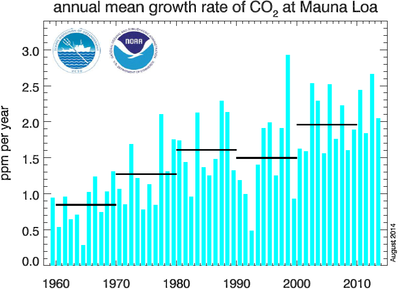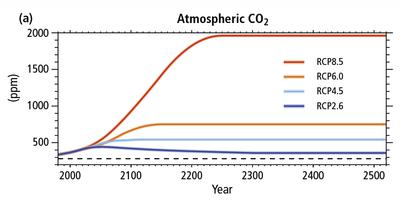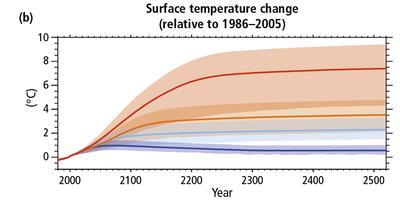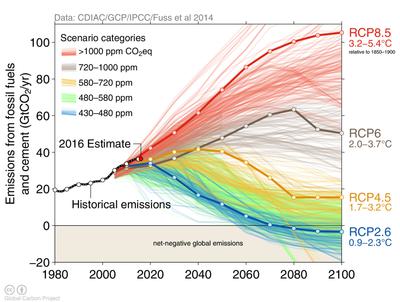Last year will go down in history as the year when the planet’s atmosphere broke a startling record: 400 parts per million of carbon dioxide. The last time the planet’s air was so rich in CO2 was millions of years ago, back before early predecessors to humans were likely wielding stone tools; the world was a few degrees hotter back then, and melted ice put sea levels tens of meters higher.
“We’re in a new era,” says Ralph Keeling, director of the Scripps Institution of Oceanography’s CO2 Program in San Diego. “And it’s going fast. We’re going to touch up against 410 pretty soon.”
There’s nothing particularly magic about the number 400. But for environmental scientists and advocates grappling with the invisible, intangible threat of rising carbon dioxide levels in the atmosphere, this symbolic target has served as a clear red line into a danger zone of climate change.
When scientists (specifically, Ralph Keeling’s father) first started measuring atmospheric CO2 consistently in 1958, at the pristine Mauna Loa mountaintop observatory in Hawaii, the CO2 level stood at 316 parts per million (ppm), just a little higher than the pre-industrial level of 280 ppm. 400 was simply the next big, round number looming in our future.
But as humans kept digging up carbon out of the ground and burning it for fuel, CO2 levels sped faster and faster toward that target. In May 2013, at the time of the usual annual maximum of CO2, the air briefly tipped over the 400 ppm mark for the first time in several million years. In 2014, it stayed above 400 ppm for the whole month of April. By 2015, the annual average was above 400 ppm. And in September 2016, the usual annual low skimmed above 400 ppm for the first time, keeping air concentrations above that symbolic red line all year.
Concentrations of carbon dioxide in Earth’s atmosphere have risen rapidly since measurements began nearly 60 years ago, climbing from 316 parts per million (ppm) in 1958 to more than 400 ppm today. Scripps Institution of Oceanography
Global temperatures have risen in parallel, with 2016 standing as the hottest year since records started in 1880: 2016 was about 1.1 degrees C (2°F) warmer than pre-industrial levels. The 2015 Paris Agreement, the latest international climate treaty, is aiming to keep the global temperature increase well below 2 degrees C, and hopefully limit it to 1.5 degrees.
At the current rate of growth in CO2, levels will hit 500 ppm within 50 years, putting us on track to reach temperature boosts of perhaps more than 3 degrees C (5.4°F) — a level that climate scientists say would cause bouts of extreme weather and sea level rise that would endanger global food supplies, cause disruptive mass migrations, and even destroy the Amazon rainforest through drought and fire.
Each landmark event has given scientists and environmentalists a reason to restate their worries about what humans are doing to the climate. “Reaching 400 ppm is a stark reminder that the world is still not on a track to limit CO2 emissions and therefore climate impacts,” said Annmarie Eldering, deputy project scientist for NASA’s Orbiting Carbon Observatory-2 satellite mission at the Jet Propulsion Laboratory. “Passing this mark should motivate us to advocate for focused efforts to reduce emissions across the globe.
THE MODERN MEASURE
Back in the 1950s, scientist Charles David Keeling (Ralph Keeling’s father) chose the Mauna Loa volcano site to measure CO2 because it is a good spot to see large atmospheric averages. Rising to 3,400 meters (11,155 feet) in the middle of the ocean, Mauna Loa samples an air mass that has already been well mixed from the inputs and outputs of CO2 far below and far away. And the site, being a volcano, is surrounded by many miles of bare lava, helping to eliminate wobbles in the measurement from the “breathing” of nearby plants.
The start of Keeling’s effort was well timed: the 1950s was also when man-made emissions really began to take off, going from about 5 billion tons of CO2 per year in 1950 to more than 35 billion tons per year today. Natural sources of CO2, from forest fires to soil and plant respiration and decomposition, are much bigger than that — about 30 times larger than what mankind produces each year. But natural sinks, like plant growth and the oceans, tend to soak that up. The excess produced by mankind’s thirst for energy is what makes the CO2 concentration in the air go up and up. Once in the air, that gas can stay there for millennia.
The so-called Keeling Curve that plots this rise has an annual wiggle because the entire planet inhales and exhales like a giant living being. In the Northern Hemisphere (where the Mauna Loa observatory is based, and also where most of the planet’s landmass and land-based plants sit), the air in spring is filled with the CO2 released by soil microbes in the thawing snow, and by autumn the CO2 has been vacuumed up by a burst of summer plant life; hence the annual high in May and low in September.
While Mauna Loa has become the global standard for CO2 levels, measurements taken in other places have confirmed the Mauna Loa results. NOAA’s network of marine surface stations, and even a monitoring station in the remote, pristine Antarctic, all passed the 400 ppm hurdle in 2016. NASA’s Orbiting Carbon Observatory-2 shows the planet hovering around 400 ppm, with variation from one place to another, mainly thanks to atmospheric circulation patterns.
Atmospheric concentrations of CO2 are now above 400 parts per million year-round globally [left], and last year surpassed 400 ppm at the South Pole. NOAA
THE LONG VIEW
In the big picture, 400 ppm is a low-to-middling concentration of CO2 for the planet Earth.
Some 500 million years ago, when the number of living things in the oceans exploded and creatures first stepped on land, the ancient atmosphere happened to be rich with about 7,000 ppm of carbon dioxide. Earth was very different back then: the Sun was cooler, our planet was in a different phase of its orbital cycles, and the continents were lumped together differently, changing ocean currents and the amount of ice on land. The planet was maybe as much as 10 degrees C (18°F) warmer than today, which might seem surprisingly cool for that level of greenhouse gas; with so many factors at play, the link between CO2 and temperature isn’t always easy to see. But researchers have confirmed that CO2 was indeed a major driver of the planet’s thermostat over the past 500 million years: large continental ice sheets formed and sea levels dropped when the atmosphere was low in CO2, for example.
Thanks to earth-shaking, slow-moving forces like plate tectonics, mountain building, and rock weathering — which absorb CO2 — atmospheric concentration of CO2 generally declined by about 13 ppm per million years, with a few major wobbles. As large plants evolved and became common about 350 million years ago, for example, their roots dug into the ground and sped up weathering processes that trap atmospheric carbon in rocks like limestone. This might have triggered a massive dip in CO2 levels and a glaciation 300 million years ago. That was eventually followed by a period of massive volcanic activity as the supercontinent ripped apart, spewing out enough CO2 to more than double its concentration in the air.
CO2 levels over the last 400 million years. The last time CO2 levels were as high as today’s was about 3 million years ago. Foster et al/Descent into the Icehouse
The last time the planet had a concentration of 300 to 400 ppm of CO2 in the atmosphere was during the mid-Pliocene, 3 million years ago — recently enough for the planet to be not radically different than it is today. Back then, temperatures were 2 degrees C to 3 degrees C (3.6 to 5.4°F) above pre-industrial temperatures (though more than 10 degrees C hotter in the Arctic), and sea levels were at least 15-25 meters higher. Forest grew in the Canadian north and grasslands abounded worldwide; the Sahara was probably covered in vegetation. Homo habilis (aka “handy man”), the first species in the Homo line and probably the first stone-tool users, got a taste of this climate as they arrived on the scene 2.8 million years ago. (Homo sapiens didn’t show up until 400,000 years ago at the earliest.)
To find a time when the planet’s air was consistently above 400 ppm you have to look much farther back to the warm part of the Miocene, some 16 million years ago, or the Early Oligocene, about 25 million years ago, when Earth was a very different place and its climate totally dissimilar from what we might expect today.
There’s a lot of debate about both temperatures and CO2 levels from millions of years ago. But the evidence is much firmer for the last 800,000 years, when ice cores show that CO2 concentrations stayed tight between 180 and 290 ppm, hovering at around 280 ppm for some 10,000 years before the industrial revolution hit. (There have been eight glacial cycles over these past 800,000 years, mostly driven by wobbles in the Earth’s orbit that run on 41,000 and 100,000 year timescales). This is the benchmark against which scientists usually note the unprecedented modern rise of CO2.
Frighteningly, this modern rise of CO2 is also accelerating at an unusual rate. In the late 1950s, the annual rate of increase was about 0.7 ppm per year; from 2005-2014 it was about 2.1 ppm per year.
Concentrations of atmospheric CO2 soared in recent decades as industrialized nations continued to pour carbon dioxide into the atmosphere and emissions in developing nations rose steeply. NOAA/Scripps Institution of Oceanography
Paleo records hint that it usually takes much longer to shift CO2 concentrations in the atmosphere; although researchers can’t see what happened on time frames as short as decades in the distant past, the fastest blips they can see were an order of magnitude slower than what’s happening today. These were typically associated with some major stress like a mass extinction, notes Dana Royer, a climatologist at Wesleyan University. During the end-Triassic extinction 200 million years ago, for example, CO2 values jumped from about 1,300 ppm to 3,500 ppm thanks to massive volcanic eruptions in what is now the central Atlantic. That took somewhere between 1,000 to 20,000 years. Today we could conceivably change our atmosphere by thousands of parts per million in just a couple of hundred years. There’s nothing anywhere near that in the ice core records, says Keeling.
FUTURE SCENARIOS
Though 400 seems a big, scary number for now, CO2 concentrations could easily pass 500 ppm in the coming decades, and even reach 2,000 by 2250, if CO2 emissions are not brought under control.
Predicting future CO2 levels in the atmosphere is complicated; even if we know what will happen to man-made emissions, which depends on international policies and technological developments, the planet’s network of natural sources and sinks is vast and interlinked. Some plants grow faster in a carbon-rich world; deforestation takes some plants out of the equation; the ocean stores different amounts depending on its temperature and circulation.
If you completely ignore the questions of what society might do to curb emissions, and what the planet might do to suck them up, and just look purely mathematically at where the Keeling Curve is going, levels cross 500 ppm around 2050.
The most recent Intergovernmental Panel on Climate Change (IPCC) report from 2013 made a more realistic estimate of what might happen, and what the temperature outcome would be.
In the IPCC’s most pessimistic scenario, where the population booms, technology stagnates, and emissions keep rising, the atmosphere gets to a startling 2,000 ppm by about 2250. (All the IPCC scenarios presume that mankind’s impact on the atmosphere levels out by 2300.) That gives us an atmosphere last seen during the Jurassic when dinosaurs roamed, and causes an apocalyptic temperature rise of perhaps 9 degrees C (16°F).
In the next-most-pessimistic scenario, emissions peak around 2080 and then decline, leading to an atmosphere of about 700 ppm and probable temperature increases of more than 3 degrees C.
In the most optimistic scenario, where emissions peak now (2010-2020) and start to decline, with humans actually sucking more carbon out of the air than they produce by 2070, the atmosphere dips back down below 400 ppm somewhere between 2100 and 2200 and the temperature increase is held under 1 degrees C in the long term.
These graphs from the Intergovernmental Panel on Climate Change show projected concentrations of CO2 [left] and projected temperature increases under different emissions scenarios, extending to the year 2500. IPCC
SLOWING DOWN
If man-made emissions were to magically drop to zero tomorrow, the concentration of CO2 in the atmosphere would start to level out immediately — but it would probably take about a decade to detect this slowdown against the background of the natural carbon cycle, according to Keeling.
Even with zero emissions, getting back to pre-industrial levels of 280 ppm is “sort of a 10,000-year proposition,” says Keeling. Atmospheric concentrations would drop relatively quickly at first, as the surface ocean sucked up a good chunk of the excess carbon in the air (that would take on the order of 100 years); then some atmospheric carbon would work its way into the deeper ocean (in about 1,000 years); then the planet’s carbon cycle — for example, the weathering of rocks — would soak up most of the rest over about 10,000 years.
It’s encouraging to see that, since 2014, total emissions have stayed basically flat despite continued growth in the global economy, mainly thanks to reduced coal burning in China. But steady emissions are a far cry from reduced emissions, zero emissions, or even “negative emissions” (where humanity uses technology to soak up more than we emit).
Real emissions plotted against the IPCC’s projections of CO2 emissions and temperature increases through 2100. Global Carbon Project
The non-profit Global Carbon Project estimates that the planet’s current trajectory of emissions is on track to meet the national commitments made as part of the Paris Agreement up to 2030, but not to meet the long-term goal of stabilizing the climate system below 2 degrees C above pre-industrial levels. So that puts us somewhere in the middle zone of the IPCC’s projections; right now it’s hard to tell which long-term path we are heading for, although the most optimistic scenario — with emissions starting to decline significantly in the next few years — is arguably out of reach.
“If humanity wishes to preserve a planet similar to that on which civilization developed and to which life on Earth is adapted… CO2 will need to be reduced… to at most 350 ppm,” Columbia University climate guru James Hansen has said. We sailed past that target in about 1990, and it will take a gargantuan effort to turn back the clock.
